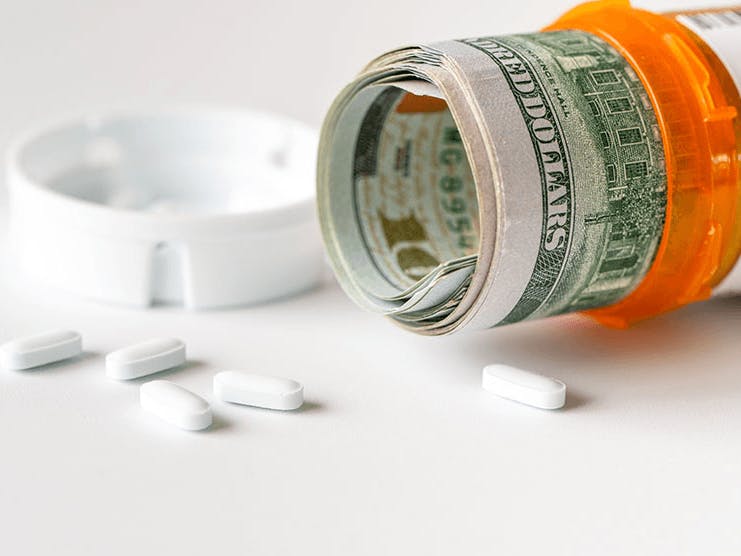
Fewer than 5% of Medicare beneficiaries ever reach the catastrophic coverage phase.
After a certain dollar amount paid out-of-pocket on prescription drugs, you automatically get “catastrophic coverage.”
Part D prescription drug plans have a drug coverage gap, also known as the “donut hole,” which provides a temporary limit on what the drug plan will cover for your prescription drugs. Once you’ve spent $8,000 in 2024, you’re out of the coverage gap and you get catastrophic coverage.
Here is more information on what catastrophic coverage and what it means for your prescription drug coverage and out-of-pocket costs.
What is Medicare Part D catastrophic coverage?
When both you and your drug plan have spent $5,030 (in 2024) on your prescription drugs, you enter the Medicare coverage gap. This includes what your plan has paid, your deductible, and the copayments and coinsurance you’ve paid. In the coverage gap, you will pay no more than 25% of the cost of your drugs, and 25% of the dispensing fee.
Then, once your total out-of-pocket costs have reached $8,000 (in 2024), you then exit the coverage gap stage and enter the next stage of Part D coverage called the “catastrophic stage.” This total is the amount that you have paid, not the total amount you and your plan have paid, for your prescription drugs.
The Medicare Catastrophic Coverage Act of 1988 expanded, for the first time, Medicare benefits to include outpatient drugs, and limit beneficiary copayments for covered services. The purpose of the coverage gap is to help protect you from having to pay high out-of-pocket costs for your prescription drugs.
Once you enter the catastrophic coverage phase, you’ll only pay a small coinsurance or copayment for covered drugs for the remainder of the year.
- $4.50 for generic drugs (or 5% of retail costs, whichever is higher)
- $11.20 for brand-name drugs (or 5% of retail costs, whichever is higher)
Keep in mind that the catastrophic coverage phase cost-sharing only applies to medications that are on your Part D plan’s formulary. If the drug is not on the formulary, you would be required to pay 100% of costs out-of-pocket.
There also is no maximum out-of-pocket for prescription drugs, so even once you enter the coverage gap, there is no limit on how much you may have to spend.
You do not leave the catastrophic stage until the start of the next year. For example, if you enter the stage in August 2024, you will not lose that coverage until January 2025. The coverage gap also does not differ, and is the same for all Part D plans.
Your Part D plan will help you keep track of how much money you’ve spent out of pocket for covered drugs, as well as your progression through the coverage periods. This information appears on your monthly statement.
What out-of-pocket costs help reach catastrophic coverage?
You reach the catastrophic stage when you have paid $8,000, not the total drug costs both you and your plan have paid. There are a number of out-of-pocket costs that help you reach catastrophic coverage, including:
- Your Part D monthly deductible
- What you paid during your Initial Coverage Period
- Nearly all of the full cost of brand-name drugs purchased during the Coverage Gap
- Amount paid by others on your behalf
- Amounts paid by State Pharmaceutical Assistance Programs, AIDS Drug Assistance Programs, and the Indian Health Service (if applicable)
Costs that do not help reach catastrophic coverage include:
- Monthly premiums
- The cost of non-covered drugs
- The cost of covered drugs from out-of-network pharmacies
- The 75% generic discount
Who is likely to enter the catastrophic phase?
The catastrophic benefit was designed to protect beneficiaries who:
- Have multiple chronic conditions
- Are prescribed multiple different drugs
- Have to take a specialty drug, such as drugs for a chronic condition or cancer treatment
What are the other phases of Part D coverage?
There are four stages of Medicare Part D coverage, each with different costs associated with them.
Annual Deductible Stage
When you fill your first prescription of the year (covered by Part D), you begin the Annual Deductible Stage. You pay the full cost of your drugs until the amount of your deductible has been reached. If your plan has a $0 deductible, you skip to the next stage.
Initial Coverage Stage
This begins after you meet your deductible. (If your plan doesn’t have a deductible, this is the first stage of your benefit coverage). You pay a copayment or coinsurance for covered prescription drugs until you reach the plan’s initial coverage limit.
Medicare Coverage Gap Stage
You enter this stage after your total drug costs have reached a certain amount ($5,030 in 2024). Your costs in this stage don't change, remaining around 25% of the cost for covered drugs. The big change is that now your Part D plan's share drops to 5% with the drug manufacturer picking up the remaining 70%.
Catastrophic Coverage Stage
You reach this stage when your total out-of-pocket costs reach a certain amount ($8,000 in 2024). During this stage, you pay a low copayment or coinsurance for prescription drugs for the remainder of the year.
Medicare Part D Costs
With a stand-alone prescription drug plan, there are a variety of out-of-pocket costs that you may have to pay, including:
- Monthly premium (if applicable)
- Annual deductible (if applicable, but no more than $505 in 2024)
- Copayments or coinsurance
- Costs in coverage gap (if applicable)
- Costs if you must pay a late enrollment penalty
Your actual out-of-pocket costs will vary based on a number of factors. For example, some plans offer $0 monthly premiums or low annual deductibles, while others charge a monthly premium or higher deductibles.
Your costs will also depend on whether or not your prescriptions are in the formulary, and what tier they fall into. Additionally, be sure to get your prescriptions filled at an in-network pharmacy to keep costs low.
How to apply for Medicare Part D Drug Coverage
There are two ways you can get Medicare Part D coverage:
- Medicare Drug Plans
These plans, offered by private insurers, will add Part D drug coverage to Original Medicare, some Medicare Cost Plans, some Private Fee-for-Service plans, and Medical Savings Account plans.
In order to enroll in a separate drug plan, you must have Medicare Part A (hospital insurance) and/or Medicare Part B (medical insurance) and live within the plan’s service area.
Once you choose to enroll in a drug plan, you can enroll with our Find a Plan tool - just enter your zip code and prescriptions to view Part D plans in your area. Other options include:
- On the plan’s website
- By completing a paper enrollment form
- By calling the plan directly
- By calling Medicare
- Medicare Advantage (MA) Plan (Part C)
With an MA plan, you’ll get Part A, Part B and Part D coverage in one plan. MA plans offer the same coverage for services and supplies that Original Medicare does, as well as additional coverage such as dental, vision, hearing and prescription drug coverage.
You can also use our Find a Plan tool to compare your Medicare Advantage Prescription Drug plan options. Again, just enter your zip code and medications to view MA-PD plans in your area. You can also:
- Call the new plan and enroll over the phone
- Enroll on the plan’s website
- Call Medicare
- Complete a paper enrollment form
Not all MA plans offer drug coverage, so be sure to do your research before selecting a plan.
When choosing a plan, make sure to choose from plans available in your service area. Compare costs, including the deductible, premiums, copayments/coinsurance. Also review the plan’s formulary to make sure any drugs you currently take are covered.
Original Medicare
To enroll in Medicare, you can:
- Apply online at www.ssa.gov
- Visit your local Social Security office (most are still closed due to the COVID-19 pandemic)
- Call Social Security
- Call the RRB (if you worked for a railroad)
If you already have Part A and want Part B, you must complete an Application for Enrollment in Part B.
Additional resources
- ClearMatch Medicare: Find a Medicare Plan
- Medicare.gov: Costs
- Social Security Administration: Extra Help



